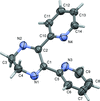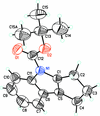issue contents
September 2016 issue

Cover illustration: In (![[eta]](/logos/entities/eta_rmgif.gif) 5-2,4- dimethylcyclopenta[b]indolyl)(
5-2,4- dimethylcyclopenta[b]indolyl)(![[eta]](/logos/entities/eta_rmgif.gif) 5-pentamethylcyclopentadienyl)zirconium(IV) dichloride, the dihedral angle between the planes of rings coordinated to Zr is 51.6 (2)°. The crystal structure features H
5-pentamethylcyclopentadienyl)zirconium(IV) dichloride, the dihedral angle between the planes of rings coordinated to Zr is 51.6 (2)°. The crystal structure features H Cl and C-H
Cl and C-H
![[pi]](/logos/entities/pi_rmgif.gif) interactions. See: Medvedev, Ryabov, Uborsky, Kononovich, Izmer & Voskoboynikov [IUCrData (2016). 1, x161408].
interactions. See: Medvedev, Ryabov, Uborsky, Kononovich, Izmer & Voskoboynikov [IUCrData (2016). 1, x161408].
metal-organic compounds
Download citation


Download citation


Open  access
access
 access
accessIn the structure of (η5-2,4- dimethylcyclopenta[b]indolyl)(η5-pentamethylcyclopentadienyl)zirconium(IV) dichloride, the dihedral angle between the planes of rings coordinated to Zr is 51.6 (2)°.
CCDC reference: 1502439
Download citation


Download citation


Open  access
access
 access
accessThe coordination polymer [Ba(tfBDC)(DMF)(EtOH)] has been synthesized by a diffusion controlled synthesis from EtOH/DMF solution (tfBDC2− = tetrafluoroterephthalate). BaO8 polyhedra are connected by bridging tfBDC2− ligands to form a three-dimensional network structure.
CCDC reference: 1502501
Download citation


Download citation


Open  access
access
 access
accessIn the title complex, the vanadium(IV) cations are coordinated by two monoanionic bidentate Schiff base ligands and two N atoms of two dimethylamide anions, forming distorted octahedral complexes.
CCDC reference: 1502927
Download citation


Download citation


Open  access
access
 access
accessIn the crystal structure of the title compound, the TiIV atoms are coordinated by a dianionic tetradentate Schiff base ligand and two O atoms of two isopropoxide anions, forming a distorted octahedral coordination sphere.
CCDC reference: 922375
organic compounds
Download citation


Download citation


Open  access
access
 access
access1,4-[4-(9,17-Dithia[3.3]metacyclophane)]-1,3-butadiyne is generated by a crystallographic inversion centre at the mid-point of the central C—C bond. Both cyclophane units exist in cisoid pseudo-boat–chair chair–boat conformations. In the crystal, the molecular packing is controlled by van der Waals interactions.
CCDC reference: 812220
Download citation


Download citation


Open  access
access
 access
accessThe title compound, crystallized with two independent molecules (A and B) in the asymmetric unit. Both molecules have an E conformation about the C=C bond of the prop-2-en-1-one unit. In the crystal, the two molecules are linked by an N—H⋯O hydrogen bond.
CCDC reference: 1452282
Download citation


Download citation


Open  access
access
 access
accessThe molecular and crystal structures of the protonated N,N′-diphenyl-4-methoxybenzamidine derivative are reported as a nitrate salt.
CCDC reference: 1501913
Download citation


Download citation


Open  access
access
 access
accessHydrogen-bonded chains propagating along [001] occur in the crystal of the title salt.
CCDC reference: 1502522
Download citation


Download citation


Open  access
access
 access
accessThe methoxy groups attached to the imidazolium ring of the cation adopt an anti conformation. In the crystal, weak inter-ionic C—H⋯F contacts are observed.
CCDC reference: 1502503
Download citation


Download citation


Open  access
access
 access
accessThe title 13-membered benzo[4,5]imidazo[1,2-d][1,2,4]triazine fused-ring system (r.m.s. deviation = 0.028 Å), makes a dihedral angle of 53.13 (7)° with the attached difluorophenyl ring and 79.98 (7)° with the attached pyridine ring. The crystal packing features aromatic π–π interactions between the 13-membered rings [shortest distance between ring centroids = 3.5682 (8) Å].
CCDC reference: 1501316
Download citation


Download citation


Open  access
access
 access
accessThe cation is protonated at the pyridine N atom and the anion is deprotonated. In the crystal, N—H⋯O and O—H⋯O hydrogen bonds and C—H⋯O interactions link the components into a three-dimensional network.
CCDC reference: 1503086
Download citation


Download citation


Open  access
access
 access
accessIn both the R- and S-efonidipine molecules, the six-membered rings of the dioxaphosphinanyl moieties display a chair conformation and the dihydropyridine rings display a flattened boat conformation. In the crystal, N—H⋯O, C—H⋯O hydrogen bonds and weak C—H⋯π interactions link the molecules into a three-dimensional supramolecular structure.
CCDC reference: 1476969
Download citation


Download citation


Open  access
access
 access
accessThe title salt contains two cations and two anions in the asymmetric unit. In the crystal, N—H⋯O hydogen bonds link the components into [010] chains, which feature  (8) loops. The crystal structure is consolidated by weak C—H⋯O and π–π interactions, forming a three-dimensional network.
(8) loops. The crystal structure is consolidated by weak C—H⋯O and π–π interactions, forming a three-dimensional network.
CCDC reference: 1503875
Download citation


Download citation


Open  access
access
 access
accessThe cation is protonated at the pyridine N atom and the anion is deprotonated at the hydroxyl O atom. The molecular structure is stabilized by weak N—H⋯O hydrogen bonds and the crystal structure features N—H⋯O, hydrogen bonds, C—H⋯O and C—H..π interactions.
CCDC reference: 1503502
Download citation


Download citation


Open  access
access
 access
accessThe molecular and crystal structure of butyl 2-[(azidocarbonyl)amino]benzoate is reported. The crystal packing is stabilized by C—H⋯π hydrogen bonds and offset π–π stacking interactions.
CCDC reference: 1504127
Download citation


Download citation


Open  access
access
 access
accessNitramines have received considerable interest from organic chemists due to the large reactivity. The title compound was prepared by nitration of 4-fluoro-N-methylnitramine. In the crystal, molecules are connected by weak C—H⋯F and C—H⋯O bonds.
CCDC reference: 1504022
Download citation


Download citation


Open  access
access
 access
accessThe whole molecule of the title dicyanoethene derivative is generated by inversion symmetry. The pyridine ring is inclined to the plane of the dicyanoethene unit (N≡C—C=C—C≡N) by 20.2 (4)°. In the crystal, molecules are linked by C—H⋯O and C—H⋯N hydrogen bonds, forming sheets parallel to (1 1), and enclosing
1), and enclosing  (10),
(10),  (22) and
(22) and  (22) ring motifs.
(22) ring motifs.
CCDC reference: 1504520
Download citation


Download citation


Open  access
access
 access
accessThe perchlorate salt of the histamine dication crystallizes in the monoclinic space group P21/c with two formula units in the asymmetric unit. One of the histidine dications is disordered and two of the four perchlorate anions are disordered.
CCDC reference: 1505211
Download citation


Download citation


Open  access
access
 access
accessIn the title organic salt complex, the cations are protonated at the pyridine N atoms and the anions are deprotonated at the hydroxyl O atoms. The crystal structure is formed by N—H⋯O and weak C—H⋯O hydrogen bonds, completed by π–π interactions.
CCDC reference: 1505554
Download citation


Download citation


Open  access
access
 access
accessIn the title molecular salt, the conformation of the anionic tetrathiacalix[4]arene, which is cone-shaped, is primarily determined by intramolecular O—H⋯O hydrogen bonds.
CCDC reference: 1504583
Download citation


Download citation


Open  access
access
 access
accessThe dihydropyrazine ring of the title compound has a screw-boat conformation. The two pyridine rings are inclined to the mean plane of the dihydropyrazine ring by 30.78 (11) and 39.37 (9)°, and to one another by 62.53 (10)°.
CCDC reference: 1504682
Download citation


Download citation


Open  access
access
 access
accessThe crystal structure of 4,7-dichloro-1H-indole-2,3-dione is reported. In the crystal, molecules are linked by N—H⋯O, C—H⋯O and π–π interactions.
CCDC reference: 1505439
Download citation


Download citation


Open  access
access
 access
accessIn the crystal struture of the title compound, molecules are linked by pairs of N—H⋯O hydrogen bonds, forming inversion dimers with an  (8) ring motif. Within the dimers, which stack along the a-axis direction, there is a weak π–π interaction [centroid-to-centroid distance = 3.5428 (11) Å] involving inversion-related thiophene rings.
(8) ring motif. Within the dimers, which stack along the a-axis direction, there is a weak π–π interaction [centroid-to-centroid distance = 3.5428 (11) Å] involving inversion-related thiophene rings.
CCDC reference: 1504924
Download citation


Download citation


Open  access
access
 access
accessThe synthesis and crystal structure of the title imidazolium salt are reported.
CCDC reference: 1505734
Download citation


Download citation


Open  access
access
 access
accessThe asymmetric unit of the title molecular salt comprises a pyridinium cation and an I− anion. The cation exists in an E,E conformation with respect to the two C=C bonds, and is relatively planar with the pyridinium ring being inclined to the benzene ring by 10.8 (2) °.
CCDC reference: 1487591
Download citation


Download citation


Open  access
access
 access
accessThe asymmetric unit of the title compound, contains two crystallographically independent molecules (A and B) with nearly matching conformations [r.m.s. overlay fit for the non-hydrogen atoms = 0.011 (1) Å]. The two molecules are linked by a pair of O—H⋯O hydrogen bonds, enclosing an  (8) ring motif, and forming an A–B dimer.
(8) ring motif, and forming an A–B dimer.
CCDC reference: 1484421
Download citation


Download citation


Open  access
access
 access
accessThe title compound, C19H18N2O2, crystallizes with two independent molecules in the asymmetric unit which differ significantly in conformation. The two molecules are linked via C—H⋯O hydrogen bonds, forming dimers which pack in rows approximately parallel to the c axis.
CCDC reference: 1504053
Download citation


Download citation


Open  access
access
 access
accessThe title molecule is essentially planar and contains one of the three methyl groups from the tert-butyl group within the plane. A mirror plane through the plane of the molecule allows the third methyl group outside the plane to be symmetrically generated opposite the second one.
CCDC reference: 1504684
Download citation


Download citation


Open  access
access
 access
accessPyrazine compounds have received considerable interest from organic chemists due to their large reactivity. The title compound was obtained by reaction of 2-aminopyrazine with isobutyryl chloride. In the crystal, molecules are connected by I⋯N halogen bonds.
CCDC reference: 1504625
Download citation


Download citation


Open  access
access
 access
accessThe N—N bond length in the title compound indicates significant double-bond character. In the crystal, molecules are connected by C—H⋯O hydrogen bonds, forming zigzag chains.
CCDC reference: 1506353
Download citation


Download citation


Open  access
access
 access
accessIn the crystal title compound, a thiosemicarbazide derivative, molecules are linked via O—H⋯N and N—H⋯O hydrogen bonds, forming chains along [001]. The chains are linked by O—H⋯S and N—H⋯S hydrogen bonds, forming a three-dimensional framework.
CCDC reference: 1506723
Download citation


Download citation


Open  access
access
 access
accessThe cation is protonated at the amine N atom and the anion is deprotonated at one of the carboxylic acid hydroxy groups. The crystal structure features weak N—H⋯O and O—H⋯O hydrogen bonds.
CCDC reference: 1498051
Download citation


Download citation


Open  access
access
 access
accessThe crystal structure of the title compound features N—H⋯O and O—H⋯O hydrogen bonds, and C—H⋯O and C—H⋯π interactions.
CCDC reference: 1507058
Download citation


Download citation


Open  access
access
 access
accessIn the structure of 5,7-dichloro-1H-indole-2,3-dione, the molecules dimerize through two N—H⋯O hydrogen bonds.
CCDC reference: 1506169


 journal menu
journal menu













































![[publCIF]](/logos/authorchecklist11.gif)





